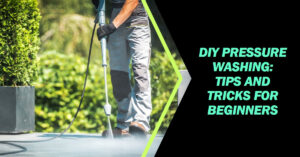Pressure washing is a versatile tool that can help rejuvenate your home’s exterior, clean your car, or even prepare a surface for painting. But how do you get started? This guide will walk you through the basics of pressure washing, from choosing the right equipment to safety measures, and provide some handy tips and tricks for beginners.
Introduction to Pressure Washing
What is Pressure Washing?
Pressure washing, also known as power washing, is a cleaning method that uses a high-pressure water spray to remove dirt, mold, loose paint, and other contaminants from surfaces. It’s a great way to clean large areas quickly and effectively.
Why Do You Need Pressure Washing?
Pressure washing is not just about making things look nice (although it does that very well!). It’s also about maintenance and prevention. Regular pressure washing can extend the life of your paintwork, prevent rot and decay, and keep your home looking its best.
Getting Started with Pressure Washing
Choosing the Right Pressure Washer
There are two main types of pressure washers: gas and electric. Gas models are more powerful but also noisier and harder to maintain. Electric models are quieter and easier to use, but may not have enough power for tougher jobs.
Understanding Pressure Washer Ratings
Pressure washers are rated by PSI (pounds per square inch) and GPM (gallons per minute). PSI tells you the pressure of the water, and GPM tells you how much water the machine uses. The higher the numbers, the more powerful the machine.
Safety Measures for Pressure Washing
Personal Protective Equipment
Safety should always be your first concern when pressure washing. Always wear protective gear, including safety glasses, gloves, and sturdy footwear.
Handling the Pressure Washer
Never point the pressure washer at people or pets, and always be aware of where you’re spraying. Keep a firm grip on the wand at all times, and be prepared for the force of the water when you start the machine.
Step-by-Step Guide to Pressure Washing
Preparing Your Area
Before you start pressure washing, clear the area of any obstacles and cover any delicate plants or items that could be damaged by the water.
Operating the Pressure Washer
Start with a low-pressure nozzle and test it on an inconspicuous area first. Work in sections, moving from top to bottom and from one side to the other. Keep the nozzle a safe distance from the surface to avoid damage.
Post-Washing Activities
After pressure washing, give the area a thorough rinse to remove any loose debris. If you used a detergent, make sure it’s fully rinsed off too.
Tips and Tricks for Effective Pressure Washing
Best Practices
Always start with the lowest pressure setting and work your way up as needed. It’s better to take a little longer than to cause unnecessary damage. Also, try to spray at a downward angle whenever possible to prevent water from getting under siding or into cracks.
Common Mistakes to Avoid
One common mistake is using too much pressure. This can damage the surface you’re cleaning and even cause personal injury. Another mistake is not using detergent when it’s needed. Detergent can help break down stubborn dirt and make your job easier.
Conclusion
Pressure washing can be a rewarding DIY task that not only improves the aesthetic appeal of your home but also contributes to its maintenance and longevity. With the right equipment, safety measures, and techniques, you’ll be well on your way to becoming a pressure washing pro.
FAQs
- What’s the difference between pressure washing and power washing?
- Power washing uses heated water while pressure washing does not. The terms are often used interchangeably, but they are technically different.
- Can I use any kind of soap in my pressure washer?
- No, you should only use soaps and detergents designed for pressure washers. Other soaps can damage the machine or harm the environment.
- Can pressure washing damage my siding?
- Yes, if used improperly. Always start with a low pressure and keep the nozzle a safe distance from the surface.
- How often should I pressure wash my house?
- It depends on your local conditions, but generally, it’s a good idea to pressure wash your home once a year.
- Can I pressure wash my car?
- Yes, but be careful. Use a low-pressure setting and keep the nozzle a safe distance from the car to avoid damaging the paint.







Comments are closed